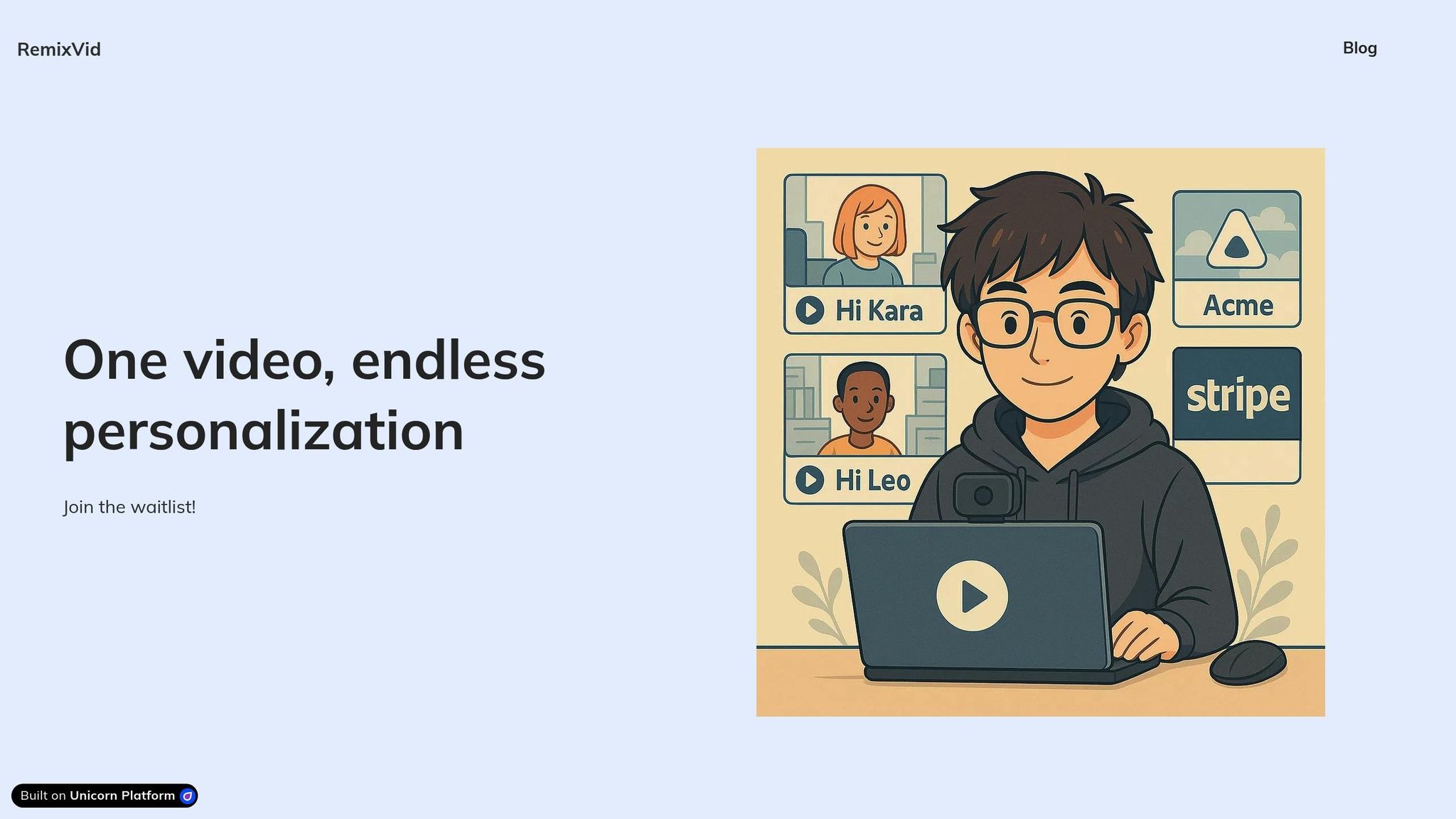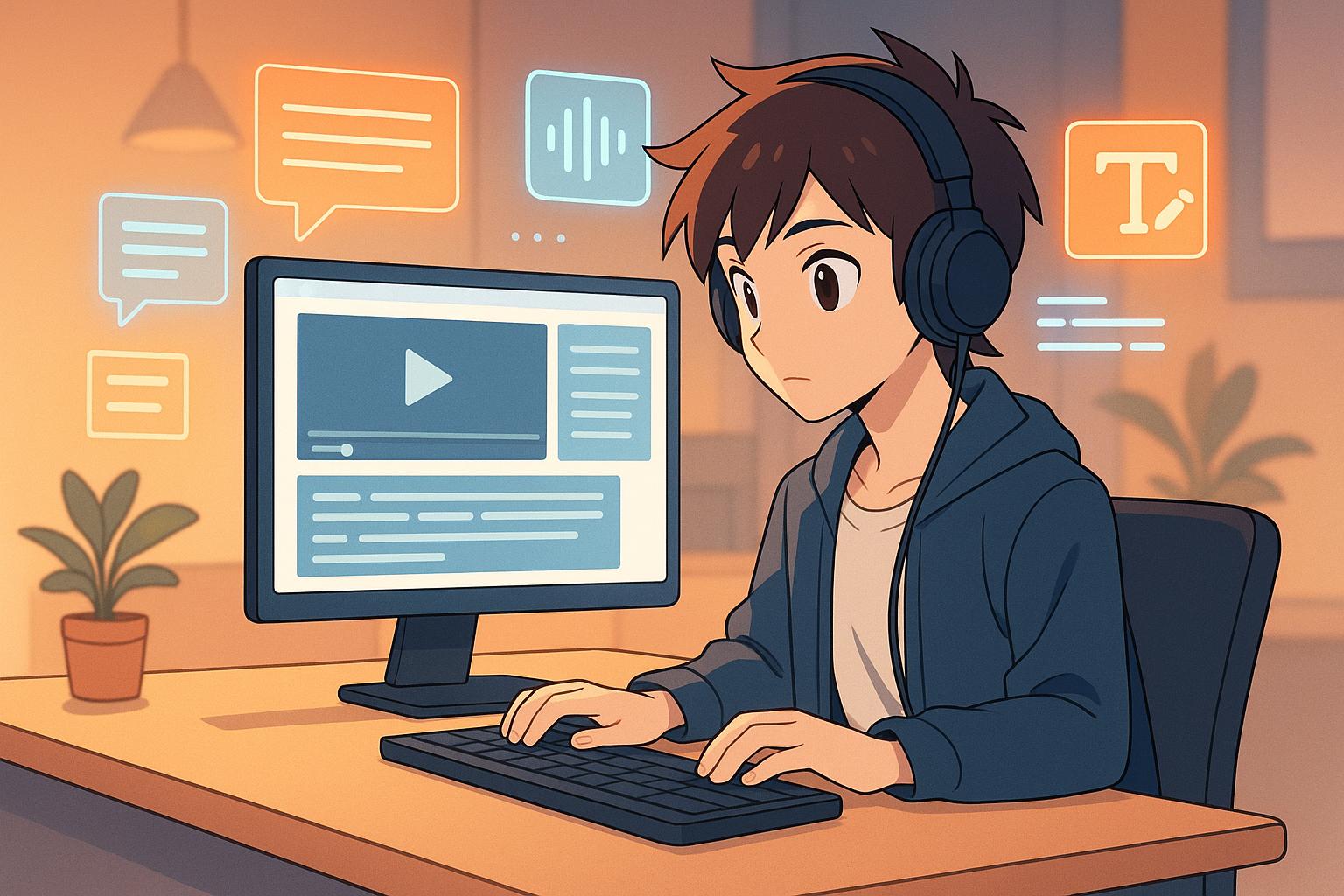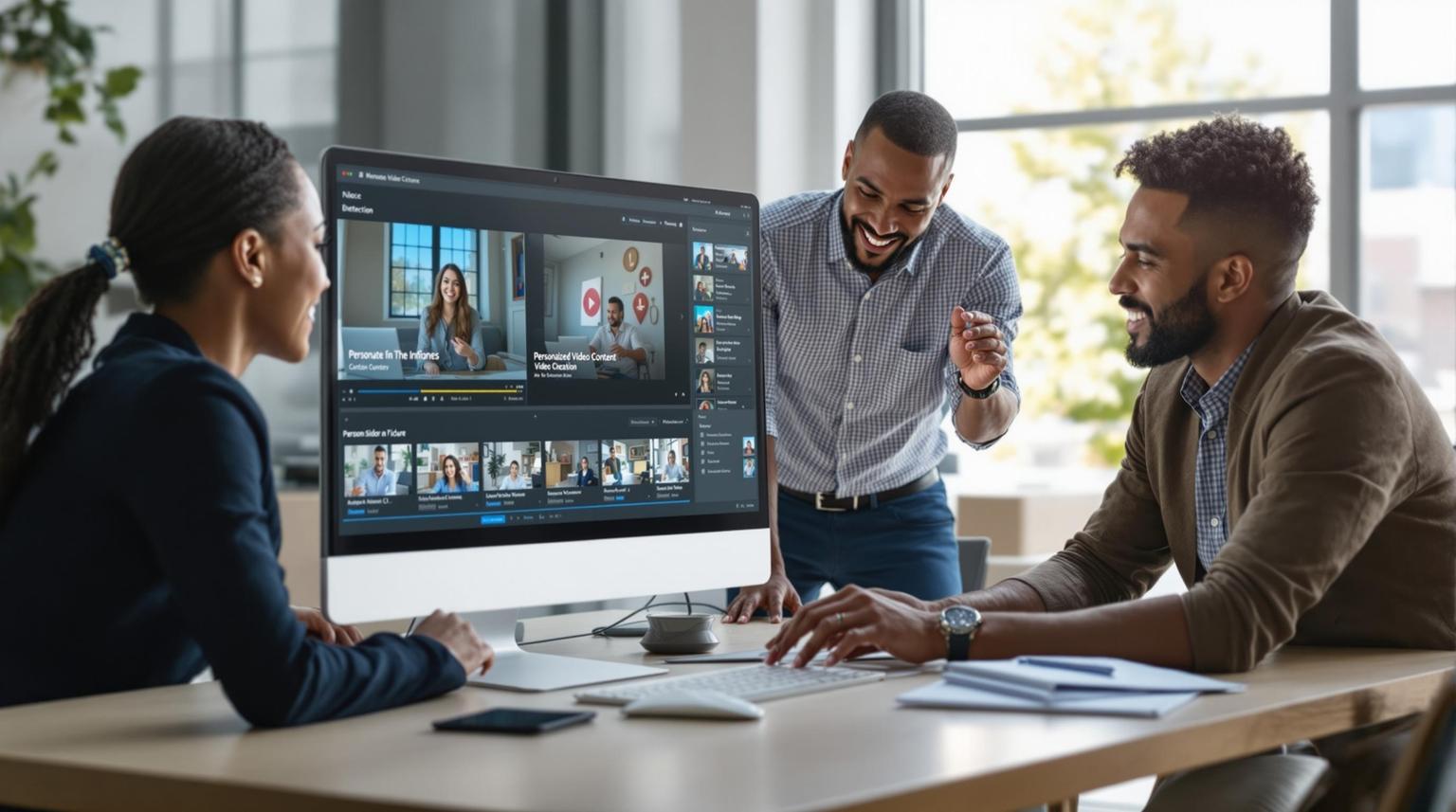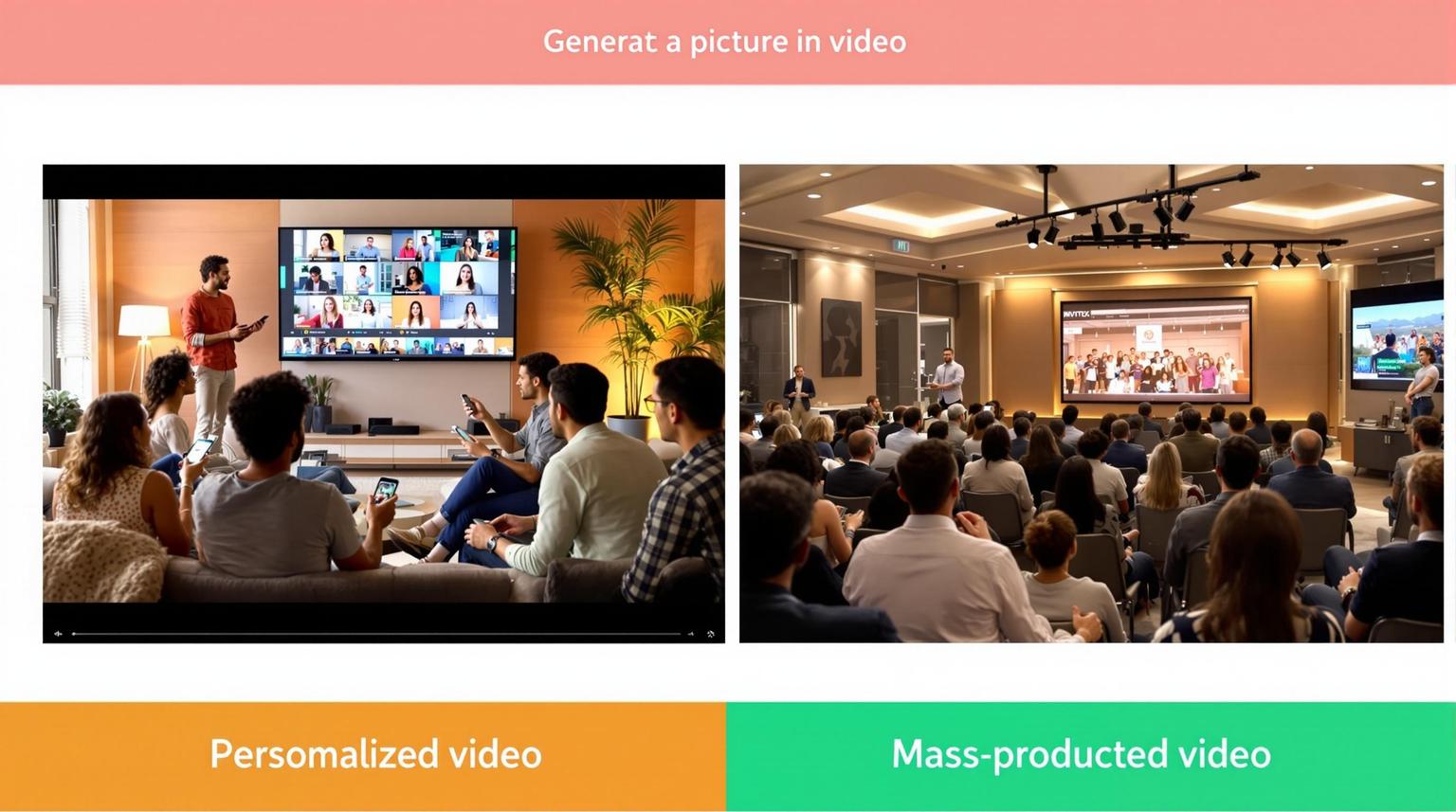AI automation in video production simplifies tasks like editing, transcription, and personalization, helping businesses save time and resources. Tools like RemixVid allow companies to efficiently create tailored videos for diverse audiences, meeting the growing demand for video content across platforms. Here's a quick breakdown:
- AI in Production: Automates repetitive tasks (e.g., editing, subtitles, and color adjustments), enabling faster workflows.
- Business Benefits: Reduces costs, increases output, and allows teams to focus on storytelling.
- Personalization: Platforms like RemixVid generate multiple customized videos from a single upload, ideal for marketing, training, and e-commerce.
- Localization: AI supports multilingual content creation, including subtitles and voiceovers, for diverse U.S. audiences.
- Efficiency Gains: AI tools cut production time significantly while maintaining quality.
AI-powered tools are transforming video production, helping U.S. businesses produce scalable, high-quality content while staying competitive.
AI Tools for Scalable Video Creation
AI Platforms for Video Production Overview
AI-powered tools are transforming video production by leveraging machine learning, deep learning, and computer vision. These platforms come packed with features like automated video creation, style transfer for visual effects, natural-sounding voiceovers in multiple languages, and extensive template libraries tailored for various formats.
The impact on efficiency is substantial. Some teams report cutting production time by half, while others have seen a 40% drop in costs, all while boosting output. These tools handle complex tasks like scriptwriting, precise captioning and subtitling, and realistic text-to-speech conversions. This makes it easier to produce videos in bulk, add multilingual voiceovers, and repurpose content for different audiences.
This sets the stage for how RemixVid takes personalization to the next level.
RemixVid Features

RemixVid is designed to scale personalized video production from a single piece of footage. Using AI transcription, the platform converts uploaded videos into editable text. Users can then insert dynamic placeholders within the transcript to allow for personalization.
Once placeholders are defined, RemixVid generates personalized video versions by seamlessly integrating new content into the original footage. With 91% of marketers identifying video as a key strategy component and over 40% planning to incorporate AI tools, RemixVid provides an efficient way to scale video production without losing consistency. This is especially useful for industries like e-commerce and services, where tailoring content to diverse markets and audiences is critical.
AI Tool Comparison for U.S. Users
When evaluating AI video tools, features, ease of use, integrations, and learning curve are top considerations. Here's how RemixVid compares to other options:
| Feature Category | RemixVid | General AI Video Platforms | Specialized Editing Tools |
|---|---|---|---|
| Primary Focus | Personalized video variations | Complete video creation | Advanced editing automation |
| Transcription | AI transcription with placeholders | Basic transcription functionality | Often manual processes |
| Personalization | Bulk customization from one video | Template-based variations | Limited personalization options |
| Learning Curve | Easy – upload and customize | Moderate – requires setup | Steep – needs technical expertise |
| Best For | Marketing, sales, and training | Content creators, social media | Professional video editors |
For U.S. businesses, producing high-quality video content at scale is a growing challenge. With digital video ads projected to make up nearly 60% of all U.S. TV and video ad spending by 2025, efficient workflows are more important than ever. RemixVid offers a streamlined solution, helping businesses create personalized, scalable video content without overwhelming their teams.
Automating Editing and Post-Production
How AI Simplifies Video Editing
AI has transformed video editing by automating repetitive tasks, giving editors more time to focus on creative decisions. Advanced AI tools now handle tasks like transcript-based editing and intelligent audio adjustments, letting editors prioritize storytelling and strategy over technical execution.
One of the most impactful areas of automation is speech-to-text technology. Tools like Premiere Pro's Speech to Text feature and DaVinci Resolve's transcription capabilities can automatically create subtitles and transcriptions with impressive accuracy. According to a March 2025 report by Editors Keys, these features not only save time but also make content more accessible.
Platforms like RemixVid take this a step further by allowing users to add dynamic placeholders directly into transcripts. This innovation enables seamless personalization without requiring additional recordings, making it especially useful for businesses creating training materials, product demos, or marketing videos tailored to specific audiences.
Visual enhancements have also seen major advancements. Adobe's Generative Fill can remove unwanted objects from a scene while intelligently filling in the background, and DaVinci Resolve's AI-powered color grading ensures consistent tones across clips, corrects skin tones, and enhances contrast. These tools simplify what used to be time-consuming manual tasks, delivering polished visuals with minimal effort.
Audio processing is another area where AI shines. Adobe's Remix tool automatically adjusts music tracks to fit a video's length while maintaining a natural flow. Other AI features like automatic audio syncing, noise reduction, and vocal clarity enhancement ensure a smoother and more professional final product. These tools also support localization efforts, making it easier to adapt content for diverse U.S. audiences.
Localization and Multiple Language Support
AI doesn't just streamline editing - it also plays a crucial role in localization, enabling businesses to create multilingual content that resonates with diverse audiences. With over 67 million Spanish speakers in the U.S. and growing communities of Mandarin, Hindi, and other language users, multilingual video content is becoming essential for broader reach.
Automated subtitle generation is one of the most efficient tools in this area. AI can process video content and produce subtitles in multiple languages simultaneously, ensuring precise timing and professional quality. This is particularly valuable for companies producing educational materials, product tutorials, or marketing content aimed at diverse communities.
Voice synthesis and dubbing technology further simplify the creation of multilingual videos. AI can replicate consistent tone and pacing across languages, eliminating the need for separate voice actors and ensuring that brand messaging stays cohesive no matter the language.
For platforms like RemixVid, localization becomes even easier. Its placeholder system lets users create templates in English and then generate personalized versions in other languages - like Spanish or French - by simply updating placeholder values. This dramatically reduces the time and cost of creating localized content for different markets.
AI also goes beyond translation by helping adapt content to specific audiences. It can tailor visual elements, pacing, and messaging to better connect with demographic groups - a critical advantage for U.S. businesses targeting diverse communities or expanding into international markets. These tools not only save time but also help ensure that content feels relevant and engaging.
Manual vs AI Editing Comparison
The efficiency of AI editing tools highlights the contrast with traditional manual workflows. Platforms like RemixVid offer a user-friendly experience that significantly reduces the learning curve compared to traditional video editing software. This intuitive design allows creative professionals to spend less time on technical training and more on making strategic, impactful decisions.
Scaling Personalized Video Content with AI
How AI-Powered Personalization Works
AI-powered personalization is reshaping video production by tailoring content to individual viewers in real time. This technology uses user data to generate specific video elements - like voiceovers, avatars, or background visuals - allowing businesses to create thousands of unique videos from a single template.
At its core, this process relies on dynamic content generation. Placeholders within video scripts are replaced with personalized elements, enabling real-time adjustments and optimization. Advanced systems go beyond simple templates, offering features like adaptive video capabilities and scalable A/B testing. For example, a training video might simplify or expand its content based on a viewer's progress, while a product demo could spotlight features relevant to the viewer's industry or role. These innovations are already finding practical applications in U.S. markets.
U.S. Business Use Cases
American companies are tapping into personalized video content to solve challenges and build stronger customer connections. For example, onboarding videos tailored to individual users can speed up adoption. A project management tool might send a new customer a walkthrough video that includes their company name, demonstrates how to set up their first project using imported data, and highlights integrations they've enabled.
This personalized approach is also transforming internal training and communications. Instead of generic training sessions, businesses now provide videos tailored to specific departments, job functions, locations, or even employee tenure. One standout example is BSH, which saw a 30% increase in engagement with personalized e-learning compared to traditional formats like text-based modules and PowerPoint presentations.
Sales teams are also leveraging AI-driven video for outreach and prospecting. Customized pitches that address a prospect's unique challenges or industry trends can lead to click-through rates increasing by as much as 985%. Marketing campaigns benefit too, with personalized videos adjusting messaging, visuals, and calls-to-action for different audience segments - all while staying on-brand. Tools like RemixVid integrate seamlessly with platforms like Sendgrid, Active Campaign, HubSpot, and Mailchimp, making it easier to embed personalized videos into existing workflows.
Measuring Personalization Results
Once AI personalization is in place, businesses often see measurable improvements in engagement and ROI. Studies show that consumers are three times more likely to prefer a personalized video over a generic one, and personalized videos are 3.5 times more effective at driving customer retention. Additionally, 65% of consumers are open to receiving AI-generated videos from brands.
Engagement metrics highlight the impact even further: personalized videos are 35% to 116% more effective than generic ones and achieve click-to-open rates that are 16 times higher. According to a 2024 McKinsey report, companies using AI in marketing achieve 20–30% higher ROI compared to traditional methods.
Efficiency is another area where AI shines. Businesses that train their teams in AI see a 43% higher success rate in deploying AI projects, while those investing heavily in AI report sales ROI improvements of 10–20%. Automation also frees up time, allowing teams to focus on creative and strategic tasks instead of repetitive production work.
To measure ROI effectively, businesses should set performance baselines before rolling out AI personalization and track both quantitative and qualitative metrics over time. A comprehensive ROI formula - (Net Benefits ÷ Total Costs) × 100 - can account for technology, training, and implementation costs. Key performance indicators should cover revenue growth, cost savings, customer experience improvements, and broader strategic outcomes. This thorough tracking ensures businesses capture the full value of their AI-driven personalization efforts.
sbb-itb-1b61896
Best Practices for AI Automation in Video Workflows
How to Adopt AI Automation
To effectively implement AI automation, focus on tasks that are both high in volume and low in risk. Start by identifying manual processes that consume significant time and resources. For instance, Netflix uses Amazon Web Services to automate video transcoding, data analytics, and content recommendations with tools like Amazon Personalize and Amazon SageMaker. This approach not only improves user experiences but also helps manage infrastructure costs efficiently.
The secret lies in prioritizing tasks that are already running smoothly. As Bill Gates aptly put it:
"The first rule of any technology used in a business is that automation applied to an efficient operation will magnify the efficiency. The second is that automation applied to an inefficient operation will magnify the inefficiency".
Begin with pilot programs that target a single process, such as video transcription, subtitle generation, or basic editing. These areas often involve repetitive or error-prone tasks, making them ideal for automation. Test the tools thoroughly to ensure they meet quality standards before scaling them across your operations.
Standard operating procedures (SOPs) are essential for maintaining consistency and helping teams understand how AI tools fit into existing workflows. Siemens exemplifies this strategy by using UiPath's robotic process automation to streamline tasks like invoice processing and data entry across departments, allowing employees to focus on more strategic work.
Executive support is critical for success. Demonstrating clear ROI and strategic value can secure leadership buy-in. With 92% of companies planning to increase AI investments over the next three years, setting clear goals and metrics is more important than ever. Collaborate with stakeholders to create governance frameworks that align with operational needs.
U.S.-Specific Considerations
When implementing AI automation in the U.S., businesses need to address unique localization and compliance requirements. For example, content must adhere to U.S. standards for currency (USD), date formats (MM/DD/YYYY), and imperial measurements.
Localization extends beyond technical details. AI tools must accommodate American English spelling (e.g., "color" instead of "colour") and incorporate regional dialects and references. This ensures video content resonates with diverse audiences across the country. Tailoring content in this way enhances its relevance and impact.
Data governance and privacy compliance are also critical in the U.S. With 73% of U.S. companies already using AI, it's vital to establish frameworks that address trust, security, and privacy concerns. Harvard Business School Professor Marco Iansiti highlights the importance of ethical considerations in AI:
"We need to go back and think about that a little bit because it's becoming very fundamental to a whole new generation of leaders across both small and large firms".
Another key factor is addressing the skill gap. Only 1% of business leaders consider their companies fully prepared for AI deployment, underscoring the need for training programs. U.S. companies should prioritize AI literacy and foster innovation through collaboration and experimentation.
Budget planning is equally important. AI tools vary widely in cost and complexity. While some solutions require significant investment and expertise, others, like RemixVid, offer more affordable, user-friendly options. A phased approach - starting with smaller projects to prove ROI - can help businesses scale their AI initiatives effectively.
AI Implementation Checklist
A well-structured approach is essential for successfully integrating AI into video workflows. Use this checklist to guide your process:
Pre-Implementation Assessment:
- Identify workflows suitable for automation.
- Pinpoint repetitive and data-heavy tasks.
- Define budgets and timelines for implementation.
- Evaluate team readiness and training needs.
Tool Selection and Integration:
- Research AI tools that align with your goals and team capabilities.
- Ensure compatibility with existing systems.
- Create feature checklists to match organizational needs.
- Test how well the tools integrate with current software and workflows.
Data Preparation and Security:
- Collect and clean relevant datasets.
- Implement encryption and security protocols.
- Establish governance frameworks that comply with U.S. privacy laws.
Team Preparation and Training:
- Develop training programs to build AI literacy and awareness.
- Communicate the benefits of AI to all stakeholders.
- Encourage feedback to ease adoption and address concerns.
- Provide resources to support ongoing tool use.
Deployment and Monitoring:
- Roll out AI tools in phases, starting with manageable tasks.
- Regularly monitor automated processes to maintain quality.
- Define governance policies for AI usage.
- Track performance metrics and adjust workflows based on results.
Long-term Success Factors:
- Allocate resources wisely: 70% to people and processes, 20% to technology, and 10% to algorithms.
- Focus on areas where AI can deliver the most value.
- Plan for scalability with robust infrastructure and change management.
- Set ambitious yet realistic timelines for implementation.
As Reid Hoffman, cofounder of LinkedIn, observed:
"AI, like most transformative technologies, grows gradually, then arrives suddenly".
Conclusion and Key Takeaways
AI Benefits in Video Production Summary
AI automation can slash video editing time by as much as 80%, allowing teams to concentrate on storytelling and strategic planning instead of repetitive technical tasks. This shift empowers creative teams to focus on crafting engaging narratives and impactful content.
By automating processes like editing, captioning, and sound design, AI reduces production costs while opening doors to increased revenue through scalable video production efforts. Additionally, AI simplifies personalization and localization with automated translation, dubbing, and subtitles.
AI also improves creative output by handling tasks like color correction, noise reduction, and video upscaling. It even supports scriptwriting and delivers real-time performance analytics to enhance the overall production process.
"AI isn't just a tool; it's your creative partner. From automating repetitive tasks to unlocking innovative possibilities, it creates a new way for teams to approach video production."
These advancements pave the way for tools like RemixVid, which use AI to make scaling video production easier and more efficient.
Why Choose AI Tools Like RemixVid
RemixVid stands out as a practical, scalable solution tailored for U.S. businesses. It addresses the challenge of creating customized video content without requiring advanced technical skills or costly infrastructure. With features like AI-based transcription and placeholders, RemixVid streamlines the process of generating multiple personalized video versions - eliminating the need for manual re-recording.
The platform is designed to be user-friendly, making it accessible to teams of varying skill levels. Unlike enterprise solutions that often require extensive training and support, RemixVid allows businesses to start small and expand their capabilities as they grow.
Quality is a cornerstone of RemixVid’s design, ensuring that all AI-generated videos maintain high standards and stay consistent with the brand’s identity. Additionally, the platform supports data-driven optimization, providing businesses with the tools to adapt to market changes. With the text-to-video AI market expected to reach $2,199.2 million by 2032, tools like RemixVid offer the flexibility needed to keep pace with evolving demands.
Next Steps for U.S. Businesses
Start by analyzing your current video production workflow to identify areas where AI can make a difference. Look for time-consuming tasks like transcription, subtitle creation, and basic editing - these are prime candidates for automation.
Take advantage of the time and cost savings that AI offers by starting small. Begin with affordable or free AI tools and gradually scale up. Build a video library to organize and manage your content more effectively. Define its purpose - whether for training, product demos, or marketing - and categorize videos by relevance, quality, and topic using tags and dates.
Introduce AI tools incrementally and provide training to help your team integrate them into their workflows. Use AI as a collaborative partner to support and enhance creative ideas, rather than as a replacement for human input.
It’s also crucial to address U.S.-specific technical and compliance needs. Implement strong data privacy policies and ensure your tools comply with legal regulations. Choose platforms that handle U.S. requirements like currency formatting (USD), date styles (MM/DD/YYYY), and American English conventions.
"The key insight for marketers in 2025 will be mastering the balance between maintaining an authentic brand voice while leveraging AI to create these personalized variations at scale. Focus on building a strong core message first, then use AI tools to adapt it for different audience segments - but always maintain human oversight on the final output to ensure quality and authenticity."
The future of video production lies in embracing AI for efficiency and scalability while preserving the human touch. Businesses that act now to integrate these tools will be better equipped to meet the growing demand for personalized, high-quality video content.
How to Build an AI Video Producer with Claude & HeyGen | Automate Your Content Creation
FAQs
How does AI automation help businesses scale video production while saving time and money?
AI is reshaping video production by taking over tedious tasks like editing, adding captions, and creating voiceovers. By automating these processes, businesses can cut production costs by as much as 40% and dramatically speed up their workflows. This shift frees up teams to focus on the creative and strategic aspects of their projects rather than getting bogged down in repetitive tasks.
On top of that, AI tools help prevent delays, deliver consistent results, and maintain high production quality. This makes it possible to create more videos in less time without sacrificing standards. For companies aiming to scale their video content, AI-powered solutions offer a practical way to save time, reduce expenses, and enhance overall efficiency.
What features does RemixVid provide to simplify video personalization and localization for U.S. audiences?
RemixVid leverages cutting-edge AI technology to simplify video personalization, allowing you to produce multiple customized versions from just one video upload. This means you can easily adjust your content to suit various regions, audiences, or demographics across the United States.
The platform makes it simple to align videos with local preferences, ensuring your message connects with viewers while cutting down on manual work. RemixVid is built to help you expand your video production capabilities without sacrificing quality or originality.
How can businesses evaluate the ROI of using AI tools like RemixVid for video production?
Businesses can determine the ROI of AI tools like RemixVid by weighing the benefits - such as cutting production costs, speeding up project timelines, and boosting audience engagement - against the total investment. A straightforward way to calculate this is by dividing the net gain by the total cost and converting it into a percentage.
To get an accurate picture of ROI, focus on tracking key metrics like shorter production times, fewer mistakes, and higher viewer interaction. For instance, features like automated editing and AI-driven personalization not only save time but also maintain top-notch quality, which can directly improve profitability. When these metrics align with your business objectives, it becomes easier to demonstrate how AI-powered tools add value and help scale video production efficiently.


